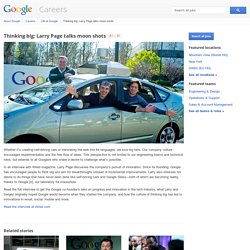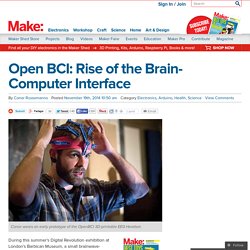

PPT "Moonshot" 1. Liftware, le nouveau moonshot de Google, est une cuillère qui vibre. Google X : lorsque Google expérimente le futur. X Lab : Google prépare l'avenir dans son labo secret. Il y a quelques jours, Google a dévoilé son Google Car, premier véhicule sans chauffeur entièrement conçu par la firme de Moutain View.

Cette voiture au look oscillant entre le jouet pour enfant et la voiturette de golf a été conçu par le [X] Lab. C’est dans ce laboratoire, qui sort petit à petit de la clandestinité, que Google réalise ses projets les plus fous. Un labo à projets dingues La division “[X] Lab” de Google se trouve à Moutain View, en Californie, à moins d’un kilomètre du quartier général de la firme.Tout de briques rouges, conçu dans un style industriel, le lieu est banal… en apparence.
Car la comparaison avec les autres bâtiments de Google s’arrête là. Le scientifique et entrepreneur Eric “Astro” Teller, son directeur, décrit l’endroit comme “la Chocolaterie de Willy Wonka“. Dans ce complexe de recherche et développement un peu spécial et tenu secret pendant des années, les inventeurs et les ingénieurs de Google préparent notre avenir. Echouer pour mieux réussir. 5 Moonshot Projects Just Crazy Enough to Work. You might think of a "moonshot" as an actual journey to the Moon or a Mickey Mantle homerun.

But at Google, the term refers to the kind of projects underway at the company's not-quite-secret lab, Google X. "Moonshots live in the gray area between audacious projects and pure science fiction; instead of mere 10 percent gains, they aim for 10x improvements," according to Google. "The combination of a huge problem, a radical solution, and the breakthrough technology that might just make that solution possible is the essence of a Moonshot. " While Google is pursuing a number of its own moonshots, from Calico and Project Loon to Google Glass and smart contact lenses, the search giant is also encouraging innovators of all stripes to pursue their own moonshots. Earlier this month, Google hosted 60 entrepreneurs and scientists at its Solve For X event to discuss 18 moonshot proposals. Artificial Solar Retina Eighty percent of what we remember and perceive comes from our eyes, according to Prof.
Solve for X. Thinking big: Larry Page talks moon shots - Google Careers. Whether it’s creating self-driving cars or translating the web into 64 languages, we love big bets.

Our company culture encourages experimentation and the free flow of ideas. This perspective is not limited to our engineering teams and technical roles, but extends to all Googlers who share a desire to challenge what’s possible. In an interview with Wired magazine, Larry Page discusses the company’s pursuit of innovation. Since its founding, Google has encouraged people to think big and aim for breakthroughs instead of incremental improvements. Larry also stresses his desire to do things that have never been done like self-driving cars and Google Glass—both of which are becoming reality, thanks to Google [x], our laboratory for moonshots. Read the interview at Wired.com This is Google A popular magazine for developers, Programmer, shows how Googlers innovate and collaborate together to help ...
See more. Open BCI: Rise of the Brain-Computer Interface. Conor wears an early prototype of the OpenBCI 3D-printable EEG Headset.

During this summer’s Digital Revolution exhibition at London’s Barbican Museum, a small brainwave-influenced game sat sandwiched between Lady Gaga’s Haus of Gaga and Google’s DevArt booth. It was Not Impossible Labs’ Brainwriter installation, which combined Tobii eye tracking and an OpenBCI Electroencephalography (EEG) device to allow players to shoot laser beams at virtual robots with just eye movement and brain waves. “Whoa, this is the future,” exclaimed one participant. But the Brainwriter is designed for far more than just games. It’s an early attempt at using Brain-Computer Interface technology to create a comprehensive communication system for patients with ALS and other neurodegenerative disorders, which inhibit motor function and the ability to speak.
The brain is one of the final frontiers of human discovery. OpenBCI 3D-printed EEG headset prototypes. The field is expanding at an astounding rate. Related. Conscious Brain-to-Brain Communication in Humans Using Non-Invasive Technologies. Human sensory and motor systems provide the natural means for the exchange of information between individuals, and, hence, the basis for human civilization.

The recent development of brain-computer interfaces (BCI) has provided an important element for the creation of brain-to-brain communication systems, and precise brain stimulation techniques are now available for the realization of non-invasive computer-brain interfaces (CBI). These technologies, BCI and CBI, can be combined to realize the vision of non-invasive, computer-mediated brain-to-brain (B2B) communication between subjects (hyperinteraction).
Here we demonstrate the conscious transmission of information between human brains through the intact scalp and without intervention of motor or peripheral sensory systems. Figures. Moonshot Thinking.